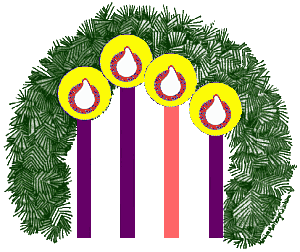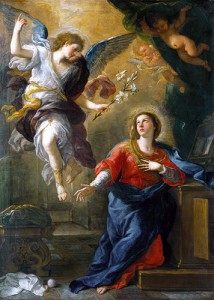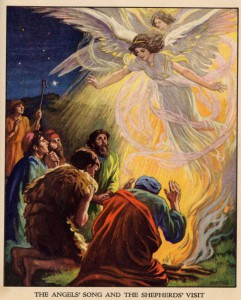 Let’s view the Collect in the Novus Ordo for the 4th Sunday of Advent, which is also the Post Communion for the Feast of the Annunciation (25 March) in the Extraordinary Form of the Roman Rite (1962MR).
Let’s view the Collect in the Novus Ordo for the 4th Sunday of Advent, which is also the Post Communion for the Feast of the Annunciation (25 March) in the Extraordinary Form of the Roman Rite (1962MR).
The Annunciation was the moment of the Incarnation of our Lord.
Therefore, on that feast and on Christmas, during the Creed of Holy Mass according to the Ordinary Form, we bend our knees instead of merely bowing at the words “Et incarnatus est…”.
Alas! Only on those two days do we kneel during the Creed with the Ordinary Form!
In the Extraordinary Form we always kneel during the Creed at that profound moment. Such gestures serve to build and reinforce our Catholic Christian identity. But I digress.
If you recite the Angelus (which has an indulgence), you know today’s Collect. It was already in the 8th century Gelasian Sacramentary.
Gratiam tuam, quaesumus Domine, mentibus nostris infunde, ut qui, Angelo nuntiante, Christi Filii tui incarnationem cognovimus, per passionem eius et crucem ad resurrectionis gloriam perducamur.
The last lines have wonderful alliteration and a snappy final cadence (glóriam perducámur). Collects are often little treasure boxes.
Cognosco is, generally, “to become thoroughly acquainted with (by the senses or mentally), to learn by inquiring…”, but in the perfect tenses (cognovimus) it is “to know” in all periods of Latin. Infundo basically is “to pour in, upon, or into” but in the construction (which we see today) infundere alicui aliquid) it is “to pour out for, to administer to, present to, lay before”. It can mean, “communicate, impart”. Perduco, “to lead or bring through”, is “guide a person or thing to a certain goal”. It can also mean “to drink off, quaff”, a nice counterpoint to infundo.
A LITERAL RENDERING:
We beg You, O Lord, pour Your grace into our minds and hearts, so that we who came to know the incarnation of Christ Your Son in the moment the Angel was heralding the news, may be guided through His Passion and Cross to the glory of the resurrection.
That angelo nuntiante is an ablative absolute. By its “present” tense it is contemporary with the time of the past tense in cognovimus. Thus, in the very moment the Angel was heralding the good news, we (collectively in the shepherds) knew about how God the Son, who had taken our whole human nature into an indestructible bond with His divinity, was being born into this world. The shepherds then rushed to the Coming of the Lord to see the Word made flesh lying in His wooden manger, which foreshadowed His wooden Cross.
OBSOLETE ICEL (1973):
Lord, fill our hearts with your love, and as you revealed to us by an angel the coming of your Son as man, so lead us through his suffering and death to the glory of his resurrection.
NEW CORRECTED ICEL (2011):
Pour forth, we beseech you, O Lord, your grace into our hearts, that we, to whom the Incarnation of Christ your Son was made known by the message of an Angel, may by his Passion and Cross be brought to the glory of his Resurrection.
“Seeing is believing”, they say, but believing makes us want to see. “Crede ut intellegas! Believe that you may understand!” is a common theme for St. Augustine of Hippo (+430 – e.g., s. 43,4.7; 118,1; Io. eu. tr. 29,6).
Today many people pit faith against reason, authority against intellect, as if they were mutually exclusive.
Faith and authority are indispensible for a fuller rational, intellectual apprehension of anything. In all the deeper questions of human existence, we need the illumination that comes from grace and revelation. We must receive and believe. Faith is the foundation of our hope, which leads to love and communion with God, as Augustine would say (trin. 8,6).
When we hear about something or learn a new thing we often rush to know more, to have personal experience, to see.
This is a paradigm for our life of faith.
There is an interlocking cycle of hearing a proclamation (such as the Gospel at Mass, a homily, or a teaching of the Church) or observing the living testimony of a holy person’s life (such as Theresa of Calcutta).
Because of an experience of reception, and subsequent pondering, we come to love the content of that which we received.
The content of the prayers which Holy Church gives us is the Man God Jesus Christ.
By hearing and pondering and using well these prayers, we come all the better to know Christ and to love Him. In loving Him we desire all the more to know Him.
Acceptance of the authority of the content of our orations at Mass opens previously unknown treasuries which would otherwise be locked.
This is why our translations are so important.

Remember! Our prayers at Mass were composed in Latin.
Some of them are ancient indeed. They are, indeed, like treasure boxes which, with the right keys, we can open to find irreplaceable riches.
Our Blessed Mother, so closely associated with today’s Collect, first received the message of the Angel.
She accepted and believed the message, and made it her own.
She pondered it in her heart.
She pronounced her Magnificat.
She brought our Savior into the light of the world.

The angel heralded with authority once again.
The shepherds accepted and believed.
They rushed to Bethlehem and pondered.
They saw the Infant.
They understood the message of the Word made flesh.
They knelt.
They worshiped.
This is the cycle of our experience of the reception of the content of our Faith in worship.


































When my children were very little, we went to Byzantine, Extrordinary Form and Novus Ordo regularly. While at a Ordinary Form Mass, one of my children recognized ‘oh, this is where we kneel.’ And just did it, the others followed suit. Then one tugged on my arm, and looked at me intently like ‘c’mon mommy! This is the part!’, so I knelt too. I was so proud that they were paying such close attention to where we were in the Mass and translating correctly to a different rite/form what they already knew, that I didn’t want to discourage them by correcting them when in reality they were doing the more right thing…As a mother I try to avoid discouraging greater reverence for Our Lord.
Now they are older and it’s just what we do across the boards. Whether praying the Angelus or at Mass we kneel in recognition of the Word being made flesh. It is the most important thing to happen in all of creation, the least we can do is dip a knee.
I think more people would kneel if they had a better understanding of what the Mass really is and Who it is they stand before….if they could see the Heavenly Court in attendance KNEELING. And isn’t it the object of this mortal life to end up among them?
Ultimately, ‘every knee shall bend’. Personally, I’d rather do it voluntarily…..
We were at a Mass recently where the Communion hymn was about kneeling before the Lord….as the congregation all went up and received the Eucharist standing and in the hand. It’s a little schizo.
I also kneel during the Creed at both forms of Mass. It’s become a habit, and I’m too old to care much what anyone thinks of me, so I just do it.
In my experience, it’s only at Christmas time that we recite the Nicene Creed rather than the Apostles Creed in the OF. So at least we are still kneeling at every Incarnatus Est that we hear.
That “obsolete 1973 ICEL” translation sums up everything that is wrong with the Modernist way of thinking. Replacing “grace” with “love”? It’s not the same thing! Yes God loves us so he gives us graces if we ask Him for them, as we do when we beseech him in the correct translation. But of course in the Modernist World we never beseech God because after all we are great and are God’s equal. Also the replacement of “Incarnation” with “coming of your son as man”. It just weakens the meaning. I could go on …
I’ll need to amend my above post, as in the Christmas Mass I just attended there was neither Apostles nor Nicene Creed. So I’ll just say: my experience, it’s only in the EF that we recite the Nicene Creed rather than the Apostles Creed or something… So at least we are still kneeling at every Incarnatus Est that we hear.
(I think the parish next to us has the Nicene Creed at Christmas time- or used to. The NO’s a real shape-shifter, isn’t it?)